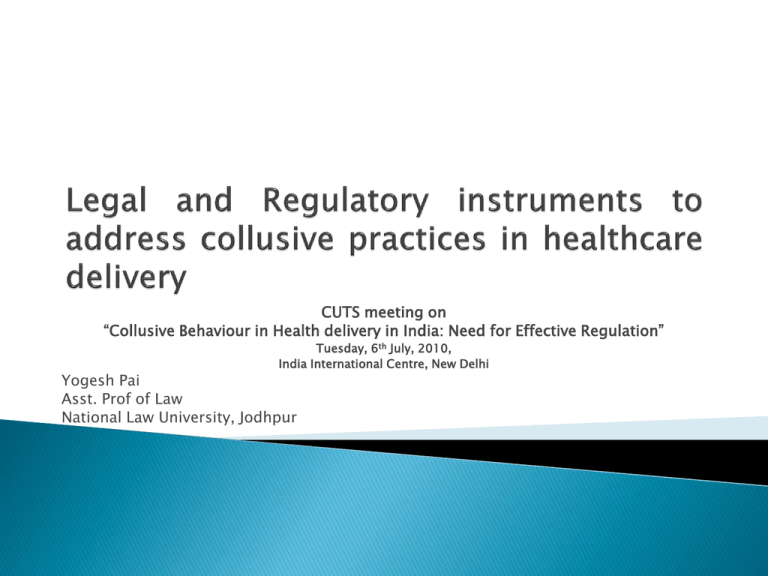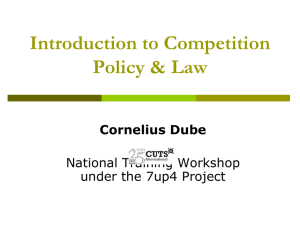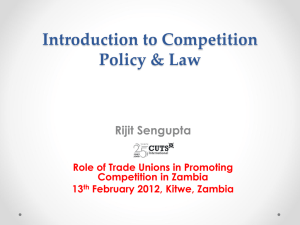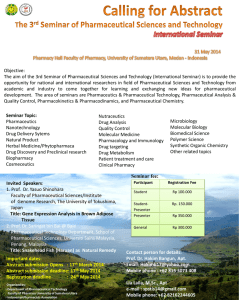Legal and Regulatory instruments to address collusive practices in
advertisement

CUTS meeting on “Collusive Behaviour in Health delivery in India: Need for Effective Regulation” Tuesday, 6th July, 2010, India International Centre, New Delhi Yogesh Pai Asst. Prof of Law National Law University, Jodhpur The context- focus on pharmaceutical industry- therapeutic drugs Systemic issues peculiar to pharmaceutical industry- supply chain and other issues Ex-ante regulatory framework to prevent abusive practices Competition Act, 2002- Anticompetitive agreements and collusive practices in health care delivery Conclusions- more questions than answers! The paradox: ◦ Access to affordable health care is central- access to medicines is at the forefront- Draft Pharmaceutical policy (2006) and other health policy instruments pointing towards the same ◦ And yet, we witness that consumers shell out of pocket expenses- private expenses in health care growing ◦ Drugs and medicines account for a vital and substantial share of healthcare in India. ◦ Household out-of-pocket (OOP) expenditure in India constitutes a sizeable 69 percent of overall healthcare expenditure. ◦ Of this, three-quarters of the total OOP health expenditure is spent on drugs. Many news reports in India and abroad and regulatory action by different competition authorities and other regulators ◦ The European Union Competition Commission inquiry of the pharmaceutical sector The EU report states: from 2000 – 2007 originator companies spent on average 17% of their turnover from prescription medicines on R&D worldwide. Approximately 1.5% of turnover was spent on basic research to identify potential new medicines. 15.5% of turnover was spent on clinical trials and to obtain marketing approval. Strikingly, expenditure on marketing and promotional activities accounted for 23% of their turnover. The collusive practice of “Pay for delay” actions by the USFederal Trade Commission Concerns over delayed entry of generics due to an existing regulatory loophole. This concern may not be of much relevance to India since there is nothing like the Hatch Waxman Act regime for term restorations or generic exclusivity period- Congress proposes to amend the law What lessons for India? ◦ Is the regulatory over-watch catching up in India?- experiences of the erstwhile MRTP regime ◦ Different set of expectations from the Competition Commission of India and other regulatory bodies DCGI, MCI. Active role of consumer groups, Pharma orgs et al. Information asymmetries lead to erratic working of competitive forces in the pharmaceutical markets. ◦ Doctor chooses, patient pays in case of prescription drugs (except generic-generics, this practice is quite visible in both generic and patented drug markets)- lack of price competition and influencing preference for a particular drug ◦ OTC- driven by advertising and marketing strategies Perverse incentives: conduct of physicians-unethical drug promotion does led to skewed nature of consumption pattern and hence impacts effective competition in pharmaceutical markets. ◦ Some genuine concerns among physicians about alleged difference in quality- between patented/originator drugs and branded generics; and/or between patented/branded generics v. generic-generics- However, factually irrelevant Drug advertising and direct to consumer marketing (DTCA) also adds to the passive exploitative situation created by information asymmetries.- more so in case of newly patented drugs Linkages in the supply chain: Evidence of linkages between pharmaceutical firms and doctors/hospitals; retailers and doctors; Stockists/wholesalers and chain pharmacies, hospitals- collusive monopsony like practices; group boycotts by pharmacists; Abuse of spatial monopoly is rampant- more seen in the case of hospital pharmacies and chemists near hospitals and other localities Price competition among retailers can be hardly witnessed- owing to its nature of collusive practices, the pharma markets are less susceptible to predatory pricing- it’s often the case of monopolistic pricing ◦ There is evidence of inefficient allocation of resources in the distribution of pharmaceutical products as studies available indicate that the profitability margins of different actors is quite high and keep huge mark-ups for nonDPCO drugs and non-scheduled drugs Possible collusive bidding in drug procurement: represents 10% of total health expenditure by Govt. ◦ While there is general downward trend in prices, studies show that the year 2007-2008 saw an increase in prices of more than 50% of drugs procured. ◦ Studies indicate that there is increasing price parallelism in super-speciality drugs being procured TMSC. (unpublished study by M. Cauksi, PHFI 2009). Reasons for proposing increased rates in bidding can be possible due to few number of firms involved and possible collusive bidding activities Regulating Perverse incentives for physicians: The Medical Council of India, Act 1956: Lax enforceability regime December 2009 amendment to the Indian Medical Council (professional conduct, etiquette and ethics) regulations 2002, has specified certain acts as running fowl the law on the relationship between the pharmaceutical industry and the medical profession in India The 2002 regulation requires prescription in generic names- “as far as possible” The amendment clearly specifies don’ts in relation to gifts, travel, hospitality, cash and monetary grants, exceptions to grant for medical research and maintaining professional autonomy; No public endorsement by a medical practitioner- any views or efficacy tests to be published in journals of scientific bodiessilence on continuing medical education (CME) The regulation does not refer to quantity of distribution of free samples: To the contrary The Pharmacy Act allows medical practitioners to dispense medicines to patients under their supervision- large scale use of free samples for commercial purpose is thus abetted Regulating Drug promotion by companies: Providing product information to physicians necessitates some amount of information exchange between physicians and pharma companies- The blurring boundaries of what constitutes fair practices are of intense debate in issues involving drugs promotion. In the year 2008, the pharmaceutical industry in India spent a total of Rs 4941.15 crore, in which Advertising expenses were 823.57 and drug marketing 2470.44 crore Indian rupees. World Health Organization (WHO-1998)- “Ethical criteria for medicinal drug promotion” states that “[s]cientific data in the public domain should be made available to prescribers and any other person entitled to receive it, on request, as appropriate to their requirements. Promotion in the form of financial or material benefits should not be offered to or sought by health care practitioners to influence them in the prescription of drugs”. However, it does not substitute domestic legislation- nothing much has worked since Drug Enquiry Committee in 1930 under the chairmanship of Sir R.N. Chopra which scrutinized the pamphlets of drugs which made spurious claims Voluntary codes by IFPMA, OPPI, IDMA and other are not meant to be rigorously pursued. Voluntary codes are antithesis to the idea of robust regulation- double standards in implementing the code Regulating conduct of pharmacists: Prescription drugs are listed under Schedule H on the Drugs and Cosmetics Act. ◦ There are about 570 molecules in this category that are stocked in a total of 5 to 8 lakh retail chemists. The Pharmacy Act, 1948: The Pharmacy Act was passed with the objective of regulating pharmacy education in the country and to regulate the profession and practise of pharmacy- A weak piece of legislation to deal with collusive behaviour among pharmacists-physicians-manufacturers/CFA/Stockists Largely deals with registration of pharmacists and maintenance of registers Section 36- Removal from register- (ii) that he has been convicted of any offence or has been guilty of any infamous conduct in any professional respect (e) that where the offence is an offence under the [Drugs and Cosmetics Act, 1940 (23 of 1940)], the registered pharmacist has not used due diligence in enforcing compliance with the provisions of that Act in his place of business and by persons employed by him [or by persons under his control]. However, Section 46. Power to make rules -2.[(kk) the conduct of pharmacists and their duties in relation to medical practitioners the public and the profession of pharmacy;- Ins. by Act 24 of 1959, sec.17 (w.e.f. 1-5-1960). Does not prescribe counter measures for resale price maintenances Does not allow pharmacists for generic substitution Advertisements and unfair trade pracitices: Drugs falling in schedules H, X (prescription drugs) and schedule G (antihistamines) of Drugs and Cosmetics Act, 1940 are currently not advertised to the public The Drugs And Magic Remedies (Objectionable Advertisements) Act, 1954: The purpose of the Act is to control advertisements of drugs in certain cases and to prohibit advertisements of remedies that claim to possess magic qualities. According to this Act, advertisement includes any notice, circular, label, wrapper or other document and any announcement made orally or by means of producing or transmitting light, sound or smoke. The schedule under the Act specifies a list of ailments for which no advertising is permitted. ◦ The list contains 54 ailments including Cancer, Venereal Diseases, Tuberculosis, and Diabetes to name a few. Apart from this, there is no specific law which prohibits advertising of prescription drugs although industry practice is not to advertise prescription- only drugs Does not have any bearing on DTCA Does not have full-proof mechanism for pre-approval of advertisements Only general guidelines applicable framed by Advertising Standards Council of India- a voluntary self regulated code Replaces the erstwhile MRTP Act, 1969- MRTP adopted a structural approach rather than an effect based approach. New economic conditions post 1991 led to enactment of the Competition Act, 2002 There were some important prosecutions against organizations of druggists and pharmacists under MRTP in relation to unfair trade practices and restrictive trade practices- often have led to conflicting decisions Competition Act primarily an ex-post measure (except pre-merger approvals) is used after evaluating anticompetitive effect in the relevant market. Competition law experiences from comparative jurisdictions suggest that it may run the risk of under enforcement or over-enforcement. Chicago and PostChicago based arguments since 1970s have made a case for under enforcement Specific regulation in certain areas may have an upper hand; but the specific regulation v. competition law jurisdictional enforcement yet to be solved Governs largely three type of anticompetitive conduct, mainly: ◦ Anticompetitive agreements (section 3) ◦ Abuse of Dominance (section 4) ◦ Regulation of combinations (sections 5&6) Restrictive trade practices and unfair trade practices in relation to healthcare delivery can be largely dealt under provisions pertaining to anticompetitive agreements (section 3)- can be further classified as horizontal or vertical agreements ◦ Horizontal agreements are those between undertakings at the same level of market, while vertical agreements are between undertakings at different levels of market. Abuse of dominance deals with issues of unilateral dominance and/or group dominance of firms- largely to do with monopolistic pricing, predatory pricing, impeding technological development, interfering in secondary markets, unfair or discriminatory conditions in purchase or sale of goods, denial of market access etc… Combinations (mergers and acquisitions) although a type of collusive practice is regulated through different provisions since they raise different type of concerns- mainly relating to foreclosure of competition Anticompetitive Agreements and its application in relation to practices in the pharmaceutical supply chain ◦ An agreement under the Act need not necessarily be written or oral- tacit understanding/arrangement to collude would suffice; such agreements need not be even enforceable by law. Not all agreements would come under the purview of anticompetitive agreements- any such agreement “which causes or is likely to cause an appreciable adverse effect on competition within India”. The test AAEC in India – section 19(3) factors may be consideredprimarily guiding towards certain anticompetitive and procompetitive factors- however, still the regulation must further scope them in to actionable outcomes Horizontal agreements (cartelization)- price fixing, output restriction and market allocation agreements- shall be presumed to have AAEC in India- a rebuttable presumption and not per se illegality Vitamins Cartel (2003)- The EC Competition Commission fined eight undertakings totalling to Euro 855.23 million (reduced to Euro 790.50 million) for running the vitamins cartel. Foreign MNCs like Roche, BASF, Aventis were found to be involved in cartels. Group boycotts by pharmacists/doctors through their associations or through smaller groups constitutes a section 3(3) violation Bid rigging or collusive bidding can be dealt with under provisions relating to anticompetitive horizontal agreements Vertical agreements- The most useful provision to deal to collusive practices in healthcare delivery (pharmaceutical supply chain) ◦ Some practices may initially appear to be unilateral but may also be a result of concerted practice, more so like a vertical agreement ◦ not all agreements (horizontal or vertical) have actual effects on markets. This is due to their weak position in the market concerned- deminimus doctrine. ◦ Healthcare supply chain presents a case of non-vertically integrated markets- where the distribution of products is undertaken in cheaper ways by different actors ◦ Vertical contracts between firms may out of necessity be procompetitive- but there can be per se illegality of certain vertical contractual restraints (e.g RPMs until 2007 US SC decision) ◦ Vertical contracts may be entered to overcome the “free-rider” problem Physicians- Drug manufactures relationship can be challenged under Section 3(4) for being an “Any agreement amongst enterprises or persons at different stages or levels of the production chain in different markets, in respect of production, supply, distribution, storage, sale or price of, or trade in goods or provision of services…”, ◦ However, AAEC must be shown- this can be shown through lack of otherwise competitive forces that must prevail in prescription marketscan be challenged as market allocations through unfair practices- also because such practices are already prohibited under some other law Retailers- Physicians relationship can also be challenged as a market allocation agreement as above A case of presumed illegality can be followed since such agreements are already prohibited under some other law Resale price maintenance can be challenged as a vertical restraint- the approach can be controversial, though Other category of vertical agreements dealing with “exclusive supply agreements”, “exclusive distribution agreements”, “tie-in agreements” and “refusal to deal” can also be challenged under vertical agreements having AAEC in the healthcare delivery system in India In EU there are Block exemptions (safe heavens) read with Commission’s guidelines on Vertical restraints, coupled with the deminimus doctrine.- the effect: most vertical agreements where the market share of each of the parties is below 30% will fall outside the scope of anticompetitive vertical restraint- provided it’s not a hardcore listed agreement The effect should be seen in a relevant product market and relevant geographic market ◦ Conditions for assessing relevant product market usually follows the ATC (Anatomical Therapeutic Classification) divided into various levels- level 3 dealing with therapeutic compounds is generally followed in pharmaceutical inquires ◦ Identification of relevant product market is fraught with difficulties since general conditions of competitive market forces are absent in “ethical drug” industry ◦ In most cases under scrutiny the Commissions usually find out the most narrowest relevant product market that is affected (except in case of merger inquiries) Is an over-regulated industry in need of more regulation?- the approach should be towards effective implementations of existing laws rather than creating new ones, except where there is an evident gap Enforcement machinery under different regulations should be put to task Competition Act, 2002 is well equipped to deal with collusive practices in healthcare delivery CCI should trump sectoral regulators if they fail to bring in regulations or to implement them- moreover, even if implement and yet AAEC seen, CCI must jump into the fray CCI may initially start with prosecuting collusive vertical agreements rather than hardcore cartels since it is difficult to detect cartels Need for detailed regulation/guidelines from the CCI on horizontal and vertical restraints- more clarity needed on what type of information exchanges and vertical restraints allowed under the Act- it would provide more business clarity and might benefit consumers as well








